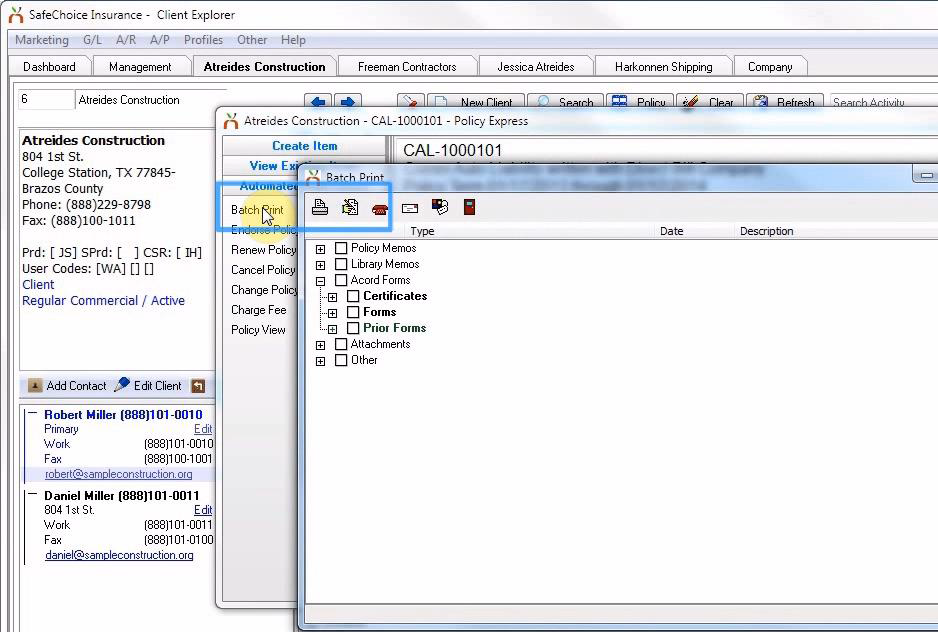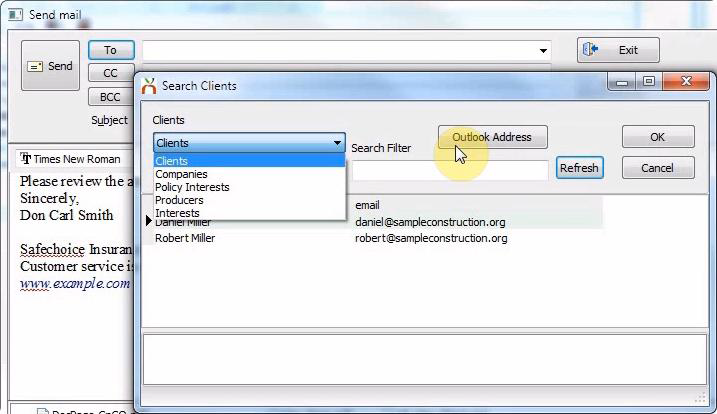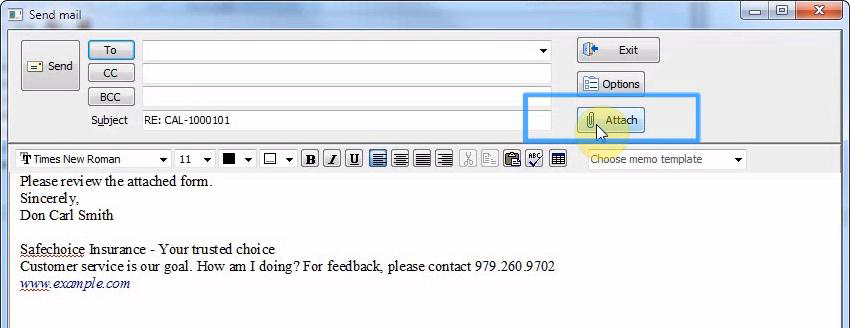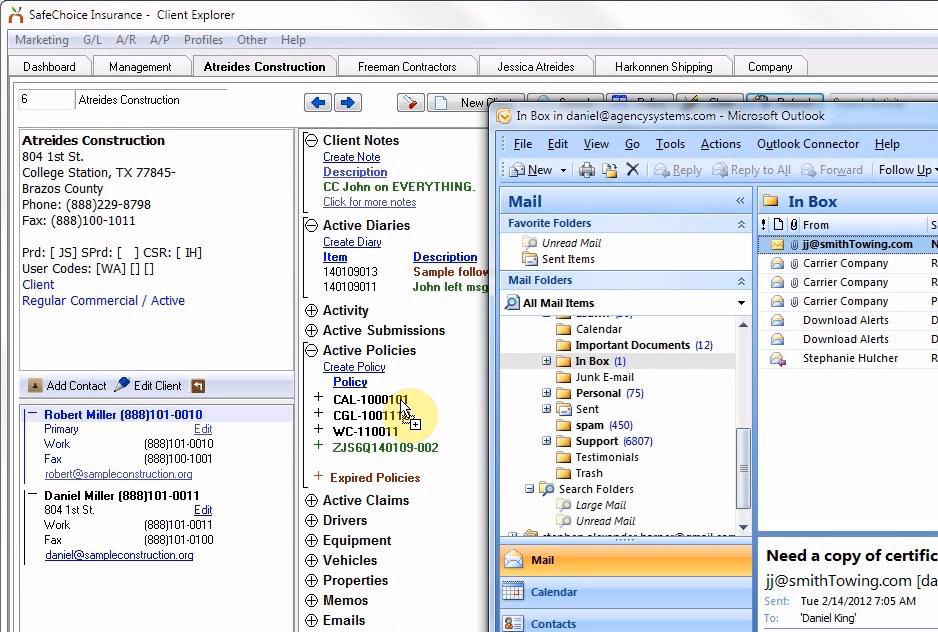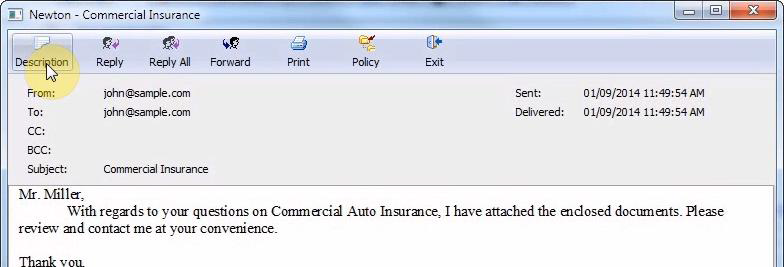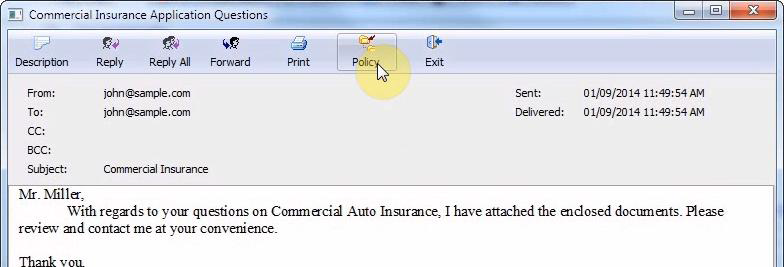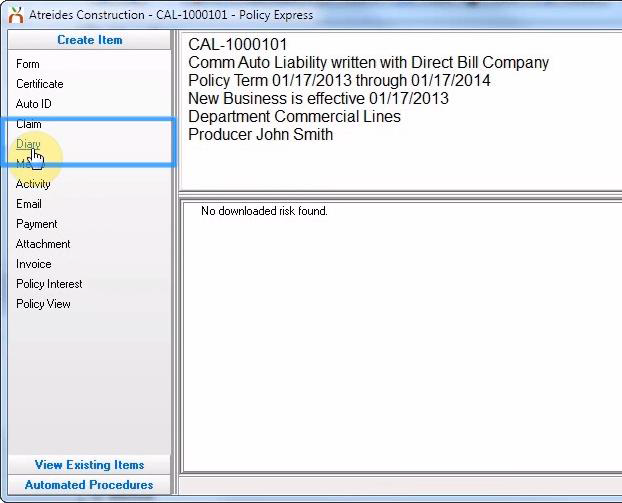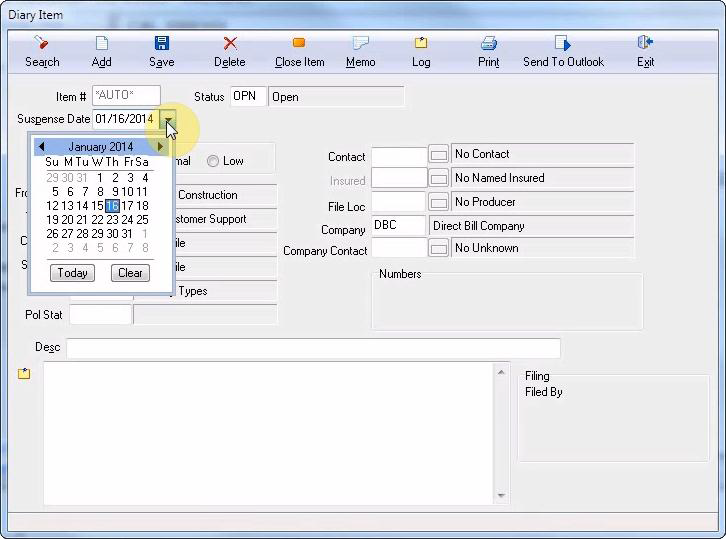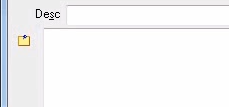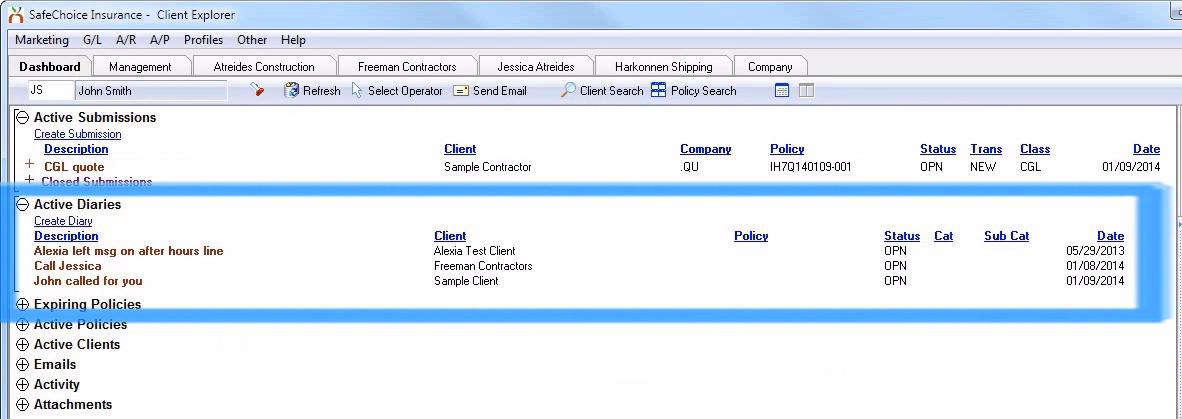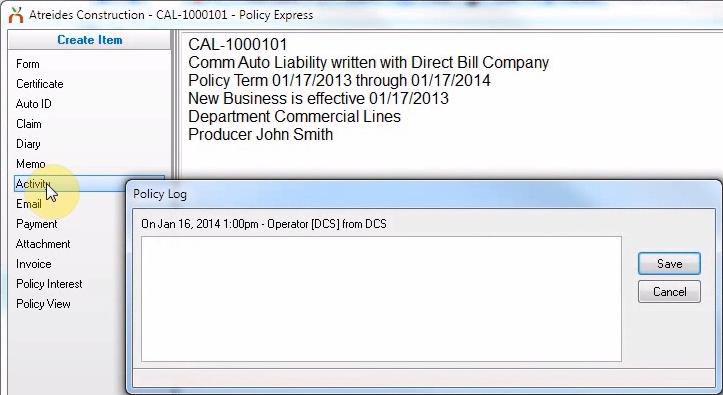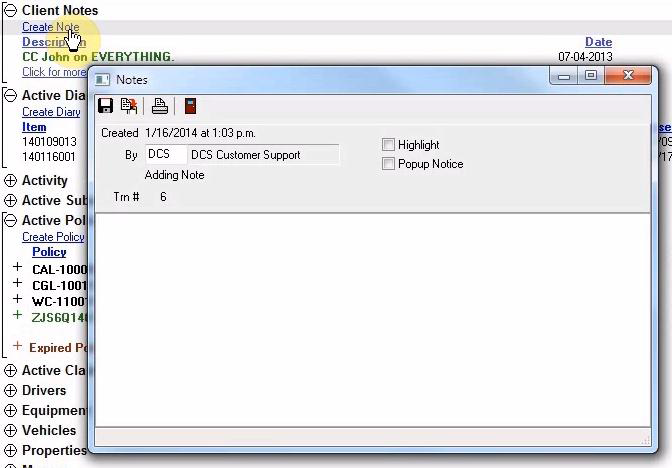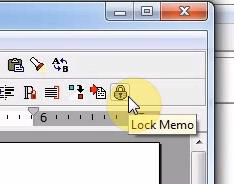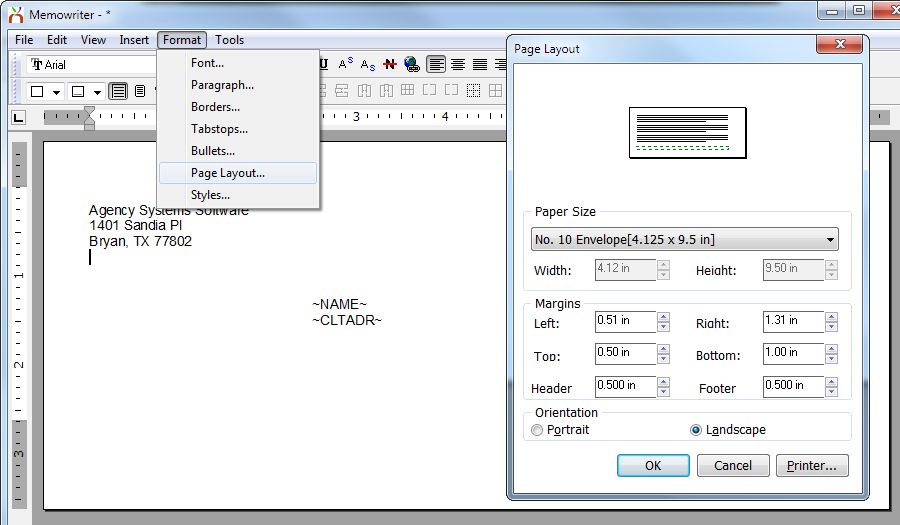Training 5: Email, Diary, Activity, Client Notes & Memo Writer
| Related Pages |
| Related Categories |
Visit: My Newton Campus - Getting Started
Contents
See Email Integration for additional details.
Sending E-mail from Newton
Newton is now integrated with Microsoft Outlook 2003 and up.
There are three ways to send e-mail from the client’s Basic tab. To e-mail a contact, click the e-mail address next to the contact’s name. Once you’ve sent the e-mail, it will be saved under the E-mails band on the client’s Basic tab.
To send a policy-related e-mail, open a policy, and click E-Mail under the Create Item menu. The e-mail will also be saved under the client’s E-Mails band.
Finally, to send policy-related documents, open a policy, select the Automated Procedures menu, and Batch Print. Use the check boxes to select Memos, forms, and attachments you wish to send, then click the E-mail button.
Address Book Options
Click To to add a recipient, CC to add a carbon-copy, or BCC to add a blind, carbon copy recipient. You can select e-mail addresses from Clients, Companies, Interests, and Producers, or click Outlook Address to select from your Microsoft Outlook contacts.
Attaching a File from Newton
Click Attach to select from your attachments in Newton. Use the checkboxes to select client and policy attachments.
Attaching a File from Your Computer
To attach a file from your computer, click and drag the file and drop it onto the e-mail.
Templates with Memo Writer
Click Choose memo template to select a form letter. It will automatically be mail-merged with the current client/policy’s information.
We will learn more about setting up Memo templates later in this training session.
E-mail Signature
Your e-mail signature will be automatically inserted into any e-mail you send from Newton. To set up your signature, click the Profiles menu and select Producer. Enter your initials and click E-mail Signature. Type your signature and click Save.
Attaching a Received E-mail to Newton
To attach an e-mail to Newton, click and drag the e-mail in your inbox and drop it onto a client or policy.
Change Description
Open an e-mail and click Description to change the description that appears on the Basic tab.
Change Policy Number
To change the policy to which an e-mail is attached, click Policy and select the policy number, or Clear to detach it from any policy. The e-mail will still be attached to the client.
Tips
- Sent e-mails are saved on the client’s Basic tab. Click Refresh to see newly added items. E-mails that are attached to a policy will list the policy number.
- Create e-mail from Policy Express to ensure that the message is attached to the correct policy.
- Create a standard naming scheme for descriptions and subject lines, making it easier to find and manage e-mails later.
- Remember that the subject and the body text of an e-mail are searchable from activity search.
Diary
Create
Diary Attached to a Client
To create a Diary on any client, load the client and click Create Diary.
Diary Attached to a Policy
To create a Diary on a policy, click the policy, and click Diary under the Create Item menu.
Suspense Date
The Suspense Date is the date on which the item should be followed up. Type the date, or select from the drop-down calendar.
Description
Enter a brief synopsis of the item. You can change the description later.
Send to Microsoft Outlook
Click Send to Outlook to create an Appointment in Microsoft Outlook with the subject and suspense date of the diary.
Color Coding
Current and future diaries appear in green. Past-due items appear in red.
Time Stamp Notes
Click the Time Stamp button to insert the current date, time, and your initials.
Any time you change the content of a diary, the change will be noted in Activity.
Categories
Click the drop-down to select a category, or right-click to create one (note that the drop-down by default reads “Not on File” until a category is selected).
Add Client Contact
Click the drop-down to select a contact (note that the drop-down by default reads “No Contact” until a category is selected).
Add Company Contact
Click the drop-down to select a contact (note that the drop-down by default reads “Not On File” until a category is selected).
E-mail Options
Click the e-mail icon next to any contact’s name to e-mail the text of the Diary to that contact.
Close Items
Click the Close Item button to change the Diary’s status to Closed, or type CLS in the Status field. Closed items no longer appear under Active Diaries nor on your Dashboard.
Dashboard
You can view open Diaries and create them from your Dashboard. Right-click a diary to open the client or print the list. Click any of the column headings to sort the list on that column.
Activity
Basic Tab
Expand the Activity band on a client’s Basic tab to view activity. Only correspondence and notes are shown by default. Right-click the Activity band to view All Items.
Policy Express
Open a policy, select the View Existing Items menu, and Policy Activity to view activity on a single policy.
Color Codes
- Correspondence appears in red.
- Notes appear in green.
- All other items appear in black.
Notes
You can add an activity note to a policy. Open the policy, and select Activity from the Create Item menu. Activity notes cannot be altered once saved.
Activity Search
Type any word or phrase to search policies, correspondence, and all other activity items. Click Clear to clear the filter.
Client Notes
Client notes appear at the top of the client’s Basic tab. Click Create Note to create a note. Client notes are attached to the client only and not to a specific policy.
Permanent Notes
Client notes are permanent and cannot be altered once saved.
Client notes are not included in Activity Search.
Highlight and Pop-up
You can choose to highlight or un-highlight a note once saved. Highlighted notes appear on the Basic tab by default; notes that are not highlighted will not appear unless you click “Click for more notes.”
The Popup Notice option will cause a note window to pop up on the screen every time a user loads the client. These should be used extremely sparingly and only for show-stopper items.
Memo Writer
Memos are word-processing documents such as form letters. Newton features an excellent word-processing system.
Create
To create a Memo, select the Marketing menu and Memo Writer.
To create a Memo on a client, click the plus-sign next to Memos and select Create Memo. You will start with a blank document either way, but if you perform a mail-merge, the Memo will remember what client you were on.
To open a Memo from your library of Memo templates, click the File menu and Open. You will learn how to set up templates in this session.
Merge Fields
Right-click and select Insert Merge Field to add a field for mail-merge. Memo Writer allows many different types of data to be merged in from clients, policies, and more, grouped into categories such as: Agent, Client, Underwriter, Policy, et cetera. For example, expand Policy and double-click Number to insert the policy number. The menu will stay open until you close it, so you can add as many merge fields as you like. A sample Memo might appear something like:
Library and Locking/Unlocking
When you have finished creating your Memo, you will save it. Memos can be saved to 4 locations: A client, a policy, a company, or to the Memo library. You should select Library. This will allow the Memo to be accessed on any client, merged, and re-saved to the given client.
Once the Memo is saved, click the Lock button to lock the Memo. A locked Memo cannot be overwritten in the library; if anyone opens it and merges the data, or otherwise changes the template, they will be prompted to re-save a copy to the current client. Only operators with a security level equal to the “Global” value for Memo Writer can lock and unlock Memos. Security can be found under the Other menu and Security System.
Save to Client or Policy
If a Memo is saved to a client it will appear under the Memos band on the client’s Basic Tab.
If a Memo is saved to a policy it will appear under the Memos band and under the View Existing Items menu in Policy Express.
Open a Memo Saved to a Client or Policy
To open a Memo saved to a client or a policy, load the client and expand the Memos band.
Memos attached to policies will show the policy number. You can click the column heading to organize Memos by policy number.
Tips
- Create an envelope template for printing envelopes. You can change the page size and orientation under the Format menu.
- Create a Memo in a Diary for Clients to sign off on changes.
- Create a Memo on the Company Tab for Underwriting Guidelines.
- Use Memos for quote worksheets, agency-created forms, or a Renewal Review Checklist to use when renewing policies.
- You may also use Memos for marketing notes on complicated commercial accounts.
